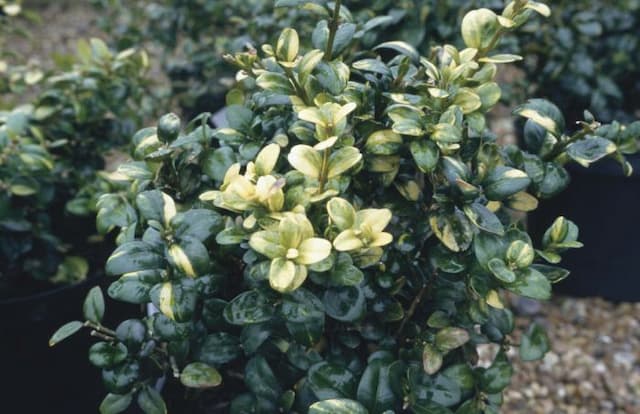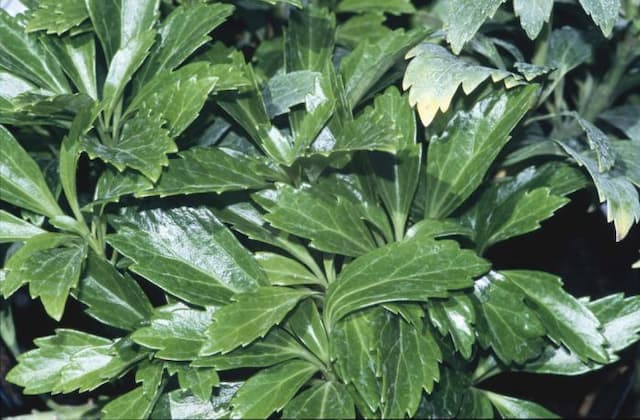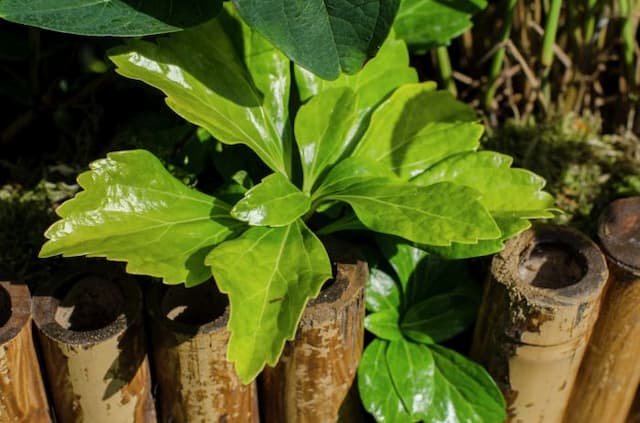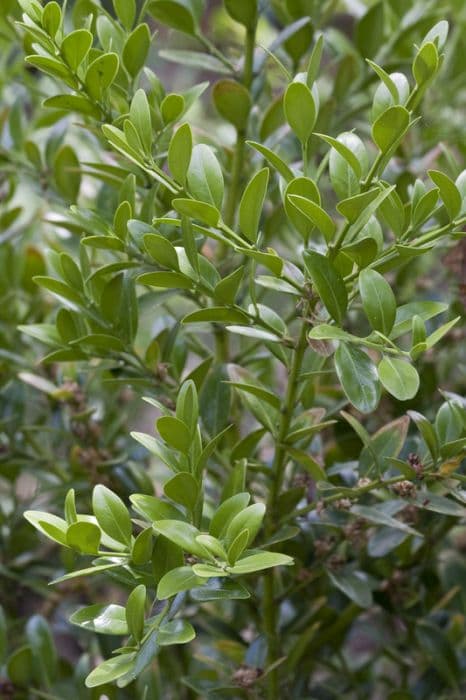Variegated Boxwood Buxus sempervirens 'Elegantissima' (v)

ABOUT
Buxus sempervirens 'Elegantissima', commonly known as the variegated boxwood, showcases a striking appearance due to its distinctively edged leaves. The foliage of this evergreen plant is characterized by a glossy, rich green color with edges that are irregularly margined with a creamy white or yellow, imparting a bright and elegant contrast. The leaves are small, oval-shaped, and arranged in an opposite fashion on the stems, which adds to the dense, bushy habit of the plant. New growth often emerges in a light green hue, further adding to the variegated spectacle as the season progresses. The overall impression given by the variegated boxwood is of a mottled tapestry of colors, ranging from deep greens to lively creams, interwoven on a compact and rounded shrub. During certain times of the year, small, inconspicuous flowers may appear, typically of a pale green or yellow color. These flowers are often hidden amongst the foliage and are not a significant feature of the plant's appeal. Instead, it is the variegated foliage that makes this plant stand out in landscape designs, offering visual interest throughout the year.
About this plant
 Names
NamesSynonyms
Variegated English Boxwood, Variegated Boxwood, Variegated Common Box, Elegantissima Variegated Boxwood.
Common names
Buxus sempervirens 'Elegantissima'
 Toxicity
ToxicityTo humans
Common box, or boxwood, is toxic to humans. All parts of the plant contain alkaloids such as buxine which can cause nausea, vomiting, diarrhea, dizziness, and respiratory failure if ingested in significant amounts. Skin contact with the sap can also cause dermatitis in some individuals. It's important to avoid ingesting any parts of the plant and to wear gloves if handling it extensively to prevent skin irritation.
To pets
Common box, or boxwood, is also toxic to pets, including dogs and cats. It contains alkaloids that can lead to symptoms such as vomiting, diarrhea, and sometimes more severe effects like seizures or respiratory failure if a pet consumes a large enough quantity. All parts of the plant are poisonous, and pet owners should prevent their animals from ingesting any parts of the plant or coming into extensive contact with its sap.
 Characteristics
CharacteristicsLife cycle
Perennials
Foliage type
Evergreen
Color of leaves
Variegated
Height
5 feet (1.5 meters)
Spread
5 feet (1.5 meters)
Plant type
Shrub
Hardiness zones
5
Native area
Europe
Benefits
 General Benefits
General Benefits- Visual Interest: Features variegated foliage that adds color and texture to landscapes.
- Low Maintenance: Requires minimal care once established, making it a good choice for gardeners of all levels.
- Year-Round Appeal: Evergreen nature ensures that the garden has greenery throughout the seasons.
- Formal Appearance: Can be easily shaped for a manicured look, ideal for formal gardens and hedging.
- Density: Provides excellent coverage for privacy screens or garden borders due to its dense growth habit.
- Drought Tolerance: Once established, it has a good level of tolerance to dry conditions, requiring less frequent watering.
- Pest Resistance: Generally resistant to common pests, reducing the need for chemical treatments.
- Wildlife Attraction: Can provide shelter for birds and beneficial insects.
- Versatility: Suitable for a variety of landscaping uses, from topiary to groundcover.
- Soil Adaptability: Adapts well to a range of soil types, though it prefers well-drained conditions.
 Medical Properties
Medical Properties- This plant is not used for medical purposes.
 Air-purifying Qualities
Air-purifying QualitiesThis plant is not specifically known for air purifying qualities.
 Other Uses
Other Uses- Buxus sempervirens 'Elegantissima', commonly known as Variegated Boxwood, is often used in topiary gardens for its ability to retain its shape well after being pruned into various ornamental forms like balls, spirals, or animal shapes.
- Variegated Boxwood hedges are frequently planted as mazes in large gardens or parks, offering both aesthetic appeal and entertainment through their labyrinthine designs.
- The dense foliage of Variegated Boxwood can be used to create a natural privacy screen around patios or other outdoor living spaces, providing seclusion without the need for fences or artificial barriers.
- The wood of Variegated Boxwood, being fine-grained and dense, is sometimes used to make small carved objects like chess pieces or intricate inlays in fine furniture and musical instruments.
- Due to its slow growth and compact nature, Variegated Boxwood is an excellent choice for bonsai cultivation, offering enthusiasts the possibility to train and shape the plant over many years.
- Throughout history, the wood of Boxwood has been employed to make printing blocks for stamping fabrics and for early forms of printing images and text before the advent of modern techniques.
- Variegated Boxwood can be planted in containers on patios, decks, and balcony gardens, where it adds structure and year-round interest with its evergreen, variegated leaves.
- In historical landscapes and period gardens, Variegated Boxwoods are used to recreate and maintain authenticity, reflecting the design sensibilities of the period.
- Variegated Boxwoods are sometimes used as a natural dye source, where the plant material is processed to color textiles or other materials.
- The dense, compact growth habit of Variegated Boxwood makes it an excellent choice for creating intricate garden knots, which are a form of formal garden design composed of interwoven hedges.
Interesting Facts
 Feng Shui
Feng ShuiThe Boxwood is not used in Feng Shui practice.
 Zodiac Sign Compitability
Zodiac Sign CompitabilityThe Boxwood is not used in astrology practice.
 Plant Symbolism
Plant Symbolism- Longevity: Buxus sempervirens, commonly known as Boxwood, has evergreen leaves, symbolizing eternal life and immortality, as it stays green throughout the year.
- Sturdiness: Boxwood is known for its hard, solid wood and the plant's resilience, denoting strength and reliability.
- Fidelity: Due to its evergreen nature and the tight, compact growth of its leaves, Boxwood symbolizes faithfulness and unwavering loyalty.
- Prosperity: Boxwood's dense foliage and its association with cultivated, manicured gardens can signify wealth, prosperity, and success.
 Water
WaterThe Common Boxwood 'Elegantissima' requires consistent moisture but is intolerant of soggy conditions. Water the shrub deeply when the top inch of soil feels dry, which is roughly once a week. During hot, dry periods, watering frequency may increase to twice a week. Each watering should provide enough water to soak the root zone, which translates to about 1-2 gallons for a small to medium-sized shrub. In winter, reduce watering since the plant requires less moisture during dormancy.
 Light
LightCommon Boxwood 'Elegantissima' thrives in a range of light conditions from full sun to partial shade. The best spot for the shrub is one where it receives morning sunlight and afternoon shade, especially in hot climates. Too much shade can lead to sparse foliage, while too much direct sun can cause leaf scorch.
 Temperature
TemperatureCommon Boxwood 'Elegantissima' can survive in temperatures as low as 0 degrees Fahrenheit and as high as 80 degrees Fahrenheit. The ideal temperature range for robust growth is between 60 and 70 degrees Fahrenheit. It is a hardy shrub that can withstand cold winters and moderate summers.
 Pruning
PruningPrune Common Boxwood 'Elegantissima' to maintain its shape and promote dense foliage. The best time to prune is in late winter or early spring before new growth starts. It can also be trimmed in summer if necessary. Pruning should be done annually, but over-pruning or too frequent pruning should be avoided to allow the plant to flourish.
 Cleaning
CleaningAs needed
 Soil
SoilBoxwood 'Elegantissima' thrives in a well-draining soil mix with a slightly alkaline to neutral pH range of 6.5 to 7.5. A mix of two parts garden soil, one part peat moss, and one part perlite or sand is ideal for proper root growth and health.
 Repotting
RepottingBoxwood 'Elegantissima' does not need frequent repotting; it can be done every two to three years. If growth slows or roots become pot-bound, it's time to repot into a slightly larger container.
 Humidity & Misting
Humidity & MistingBoxwood 'Elegantissima' prefers moderate humidity levels but is adaptable to lower humidity. Consistent moisture in the air is beneficial but not critical for its growth.
 Suitable locations
Suitable locationsIndoor
Provide bright light, occasional pruning, and well-draining soil.
Outdoor
Plant in well-draining soil with partial to full sun exposure.
Hardiness zone
5-9 USDA
 Life cycle
Life cycleCommon Box or Boxwood 'Elegantissima' (variegated form of Buxus sempervirens) starts its life as a seed, which germinates in moist, well-drained soil preferably in spring. After germination, it enters the seedling phase, establishing itself with a small root system and showing its first set of true leaves with a creamy-white variegation on the leaf margins. Following this, it enters a prolonged juvenile phase, growing slowly and can be shaped or pruned as desired; in this stage, the plant develops its dense, evergreen foliage, becoming a mainstay in formal gardens and hedges. As it matures, the Boxwood 'Elegantissima' reaches its adult phase, characterized by a more extensive root system and robust foliage; it may occasionally produce small, inconspicuous yellow-green flowers in spring, though these are often overlooked due to the ornamental foliage. In the final phase of its life, the plant may experience reduced vigor and can become susceptible to diseases like Boxwood blight or pests like the Boxwood psyllid, requiring careful management to maintain health. Ultimately, when the Boxwood 'Elegantissima' reaches the end of its lifespan, which can be several decades long, it dies back, and if conditions allow, its seeds may start the cycle anew.
 Propogation
PropogationPropogation time
Midsummer to early autumn
The most widely used method to propagate Buxus sempervirens 'Elegantissima', commonly known as Variegated English Boxwood, is through semi-hardwood cuttings. Typically, the best time to take cuttings is in the late summer to early fall, ensuring that the plant has had the full growing season to develop mature, yet still somewhat pliable, stems. One would cut a 4 to 6-inch (10 to 15 cm) length of stem that includes a couple of leaf nodes, remove the leaves from the lower half of the cutting to expose the nodes, and perhaps treat the cut end with a rooting hormone to encourage root development. The cutting is then planted in a moist potting mix, ensuring that at least one node is below the soil surface. The pot should be placed in a warm environment with a high humidity, which could be maintained by covering the pot with a plastic bag to create a greenhouse effect. With proper care, including keeping the soil consistently moist and providing dappled sunlight, the cuttings typically root within a few weeks to months, depending on conditions.









